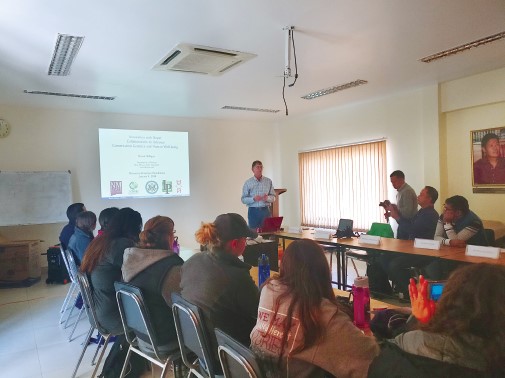On Thursday, January 4th, 2018, a most interesting group of people gathered at the Resources Himalaya Foundation premises in Sanepa, Kathmandu—researchers from the Foundation itself, team members from the Centre for Molecular Dynamics Nepal (CMDN), students from New Mexico State University (NMSU) accompanied by Professor Dr. Brook Milligan, and Nepali students, professors and scientists from a number of local educational institutions. The students from NMSU had been spending time in Nepal conducing field and lab work in the area of conservation biology, and the event was being held to share experiences and learn from each other. Those speaking were both national and international experts in their various fields of study.
Safeguarding the country’s wildlife is a vital endeavor for certain, but I hadn’t expected the event to be so fascinating and informative, even for a relative layperson in the field of science and conservation such as myself.
Speakers included Dibesh Karmacharya from CMDN, who spoke on the organization's efforts in wildlife conservation genetics research. Picking up and analyzing animal feces (scat is the technical term) may not seem very glamorous, but it’s been a key way that those involved have been successful in building a genetic database of wildlife in Nepal, such as the country’s endangered Bengal tigers. Similar programs that analyze the remains found in the country’s rivers is underway to build a fish database, as well as one for migratory birds, and the hope is that this will lead to the ability to clearly map the country’s wildlife, migratory patterns, and ups and downs which will help to gain much-needed insight to help both scientific researchers and government policy makers working on the topic.
 Two researchers from the Resource Himalaya Foundation also shared presentations—“Himalayas and Wildlife” by Naresh Kusi, and “Save the Frogs” by Biraj Shrestha. I really found their talks fascinating—it’s really great to see these young, passionate local field researchers and all that they are accomplishing. Naresh Kusi has spent long months in the areas of Humla, Dolpo, Jumla and other places in the Himalayan range, observing, talking to locals, and taking some great pictures. He’s photographed several species of birds and mammals that were thought to be no longer found in the country, and in fact it’s his photograph of the wild yak that now graces the back of the five rupee note in place of the two domestic yaks on the older bill.
Two researchers from the Resource Himalaya Foundation also shared presentations—“Himalayas and Wildlife” by Naresh Kusi, and “Save the Frogs” by Biraj Shrestha. I really found their talks fascinating—it’s really great to see these young, passionate local field researchers and all that they are accomplishing. Naresh Kusi has spent long months in the areas of Humla, Dolpo, Jumla and other places in the Himalayan range, observing, talking to locals, and taking some great pictures. He’s photographed several species of birds and mammals that were thought to be no longer found in the country, and in fact it’s his photograph of the wild yak that now graces the back of the five rupee note in place of the two domestic yaks on the older bill.
Biraj Shrestha was all about reptiles—frogs, snakes and the like. Here also, patience is the key, along with close teamwork and communication with the local community, a point that Naresh Kusi also stressed. Involving the people who actually live in the area in protection and conservation efforts appears to have been a real key in the success of these grass-roots projects.
Lastly, Prof. Dr. Brook Milligan, Director of the Conservation Genomics Laboratory and Professor of Biology at New Mexico State University shared some fascinating insight into the new advances and technology being developed which, has the potential to put tools for animal genetic testing in the hands of more people, and can hopefully lead to more information gather and a deeper, more widespread and thorough knowledge of this country’s wonderful diversity of animal life.
It was both informative and heartening to sit through the talks and presentations. I left with a renewed respect for all of the wonderful work that is being done now and planned for the future, and particularly encouraged by the way these endeavors were mainly local, home-grown ones; in Nepal, by Nepalis, for Nepalis, to paraphrase CMDN’s motto. This is as it should be, and it’s very encouraging for the future of the country’s wildlife conservation efforts.












